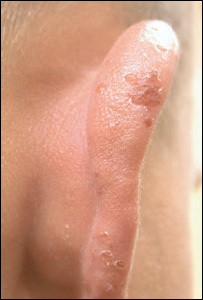The condition affects the ears, which become hot, itchy and sore before blistering and crusting.

|
| ©Blackwell Publishing |
| Affected farmers have blisters on their ears |
A study in the British Journal of Dermatology found it only occurs during lambing season, which lasts up to three months, but the cause is unclear.
The researchers from Southampton believe "lambing ear" may be a problem associated with indoor farming.
George Heathcote, a farmer from Hampshire and one of the study's authors, had consulted doctors at Southampton General Hospital after experiencing blistering on his ears, which he was convinced was linked to lambing.
Mr Heathcoate decided to write a letter to Farmers Weekly magazine to find out how many other farmers had the condition.
A total of 69 responded, all of whom said the condition only occurred during lambing or calving.
But similar letters in farming magazines in Australia, New Zealand and the Falklands found no one in those countries who seemed to be affected.
Dermatologists at Southampton carefully assessed five patients with the condition, which had not been previously reported in medical journals or textbooks.
Fluids
They could not explain what was causing the blisters although they found the condition was very similar to a rash which can occur in children due to a "sunshine allergy".
However, most of the farmers with the condition did lambing indoors and there was nothing unusual about the lighting in the sheds. As the disorder only occurs during lambing, it may be something to do with the practice itself, the researchers believe.
Professor Peter Friedmann, consultant dermatologist at Southampton General Hospital, said: "During shearing, which takes place in May or June and may be indoors or outdoors, the same farmers who suffer lambing ears can shear the sheep with no symptoms at all.
"This suggests that bodily fluids from the sheep, such as amniotic fluid, sac and placenta, or chemicals used as part of the process, play a part, although intriguingly, the disorder does not affect the hands, which have maximum contact with fluids and products involved in lambing."
He added in Australia, New Zealand and the Falklands lambing occurs outdoors with little intervention from farmers which may explain why the condition does not occur there.
Nina Goad of the British Association of Dermatologists said the study showed how dermatologists were coming up against new conditions on a regular basis.
"Following foot and mouth and blue tongue, the discovery of a disease affecting the farmers themselves may seem like an extra blow.
"However, it is actually positive that the disorder has been identified and can now be shared with dermatologists across the UK, as it will allow for more research and shared knowledge."



"Initial report of a cutaneous T-cell lymphoma appearing on the auricular helix" [Link]
Abstract
"We report a case of cutaneous T-cell lymphoma in which the first sign of disease was involvement of the superior auricular helix.
A review of the literature reveals that T-cell lymphoma often presents cutaneously, but it usually does not involve the ear, and an auricular lesion is rarely the first sign.
The uncommon nature of this presentation, in addition to the potential need for multiple biopsies for a tissue diagnosis, can lead to a delay in diagnosis. When evaluating skin lesions in the head and neck, a high index of suspicion for cutaneous T-cell lymphoma is a key factor in its early diagnosis."
So it sounds like some sort of auto-immune disease. The fact that the affected people are farmers is probably significant.
With all the nasty chemicals that get sprayed all over our food - and the farmers growing it - this has probably been going on for a while.
The above excerpt was taken from Ear, Nose & Throat Journal, May, 2000.